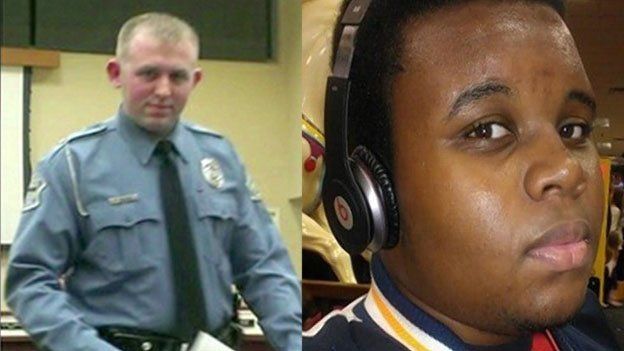Michael Brown: The workings of the grand jury explained
- Published

The grand jury has decided not to indict Darren Wilson, the white police office who shot and killed the black teenager, Michael Brown, in Ferguson, Missouri on 9 August.
The shooting led to days of clashes between protesters and police in Ferguson, and there was further unrest following the decision.
What is a grand jury?
In many countries, the decision to indict someone for a crime comes down to the opinion of a single judge who reviews the evidence and decides whether or not it is sufficient.
But in the United States, a grand jury of ordinary citizens who represent the community is often used to decide whether there is enough evidence to pursue a prosecution.
While all states have provisions to allow for grand juries, only around half use them, with other states preferring to rely on a preliminary hearing to determine whether or not to indict a defendant.
Grand jury members may be called for duty for months at a time, but need only appear in court for a few days out of every month.
Usually the only lawyer present in grand jury hearings is the prosecutor, who will present evidence. The jury has the power to request to see and hear any evidence it wants.
Grand jury proceedings are conducted behind closed doors to encourage witnesses to speak freely and to protect the defendant's reputation in case the jury does not indict.
Even though a grand jury may decide not to indict, a prosecutor could still bring the defendant to trial if they think they have a strong enough case.
Who is the grand jury in this case?
There are 12 randomly picked citizens in this Missouri grand jury - six white men, three white women, one black man and two black women.
The grand jury was based in the justice centre in Clayton, Missouri.
This jury had been hearing evidence in this case since 20 August.
It was given until 7 January to complete proceedings.
Normally a grand jury would meet just once a week, but in this case the jury had been meeting more frequently.
This was because instead of considering an overview of the case as presented by the prosecutor, jurors were asked to act as co-investigators and consider all evidence available.
Analysts say this approach is allowed under law and it is often used in high-profile indictments.
What charges did the grand jury consider?
The grand jury was deciding whether Officer Wilson should be charged with any one of four possible crimes: first-degree murder, second-degree murder, voluntary manslaughter or involuntary manslaughter.
It also had the option of charging the policeman with armed criminal action, if it could prove he was carrying a loaded firearm with the intent to commit a felony.
Nine out of the 12 members of this jury would have had to vote yes to indict Officer Wilson.
Analysts said if Officer Wilson could establish he had a "reasonable" fear for his own safety or the safety of others when he shot Brown, then he would be able to argue successfully that he was acting in self-defence under Missouri law.
Why is this grand jury controversial?
Brown's family and his supporters complained about the secrecy surrounding the grand jury's proceedings.
However, grand juries typically meet behind closed doors to assess evidence.
The prosecutor, Robert McCulloch, was criticised for being biased because his own father, a policeman, was shot and killed by a black man in 1964.
Many protestors were concerned that Mr McCulloch was not impartial and called for the appointment of a new special prosecutor to replace him.